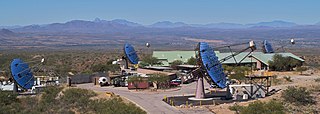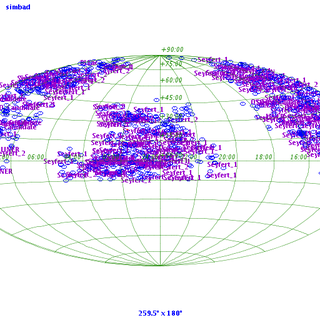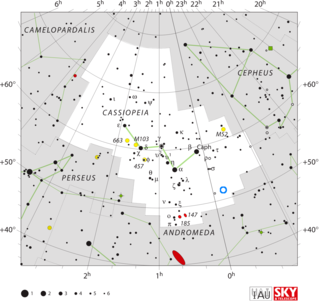
In gamma-ray astronomy, gamma-ray bursts (GRBs) are immensely energetic explosions that have been observed in distant galaxies. They are the most energetic and luminous electromagnetic events since the Big Bang. Bursts can last from ten milliseconds to several hours. After an initial flash of gamma rays, a longer-lived "afterglow" is usually emitted at longer wavelengths.

A blazar is an active galactic nucleus (AGN) with a relativistic jet directed very nearly towards an observer. Relativistic beaming of electromagnetic radiation from the jet makes blazars appear much brighter than they would be if the jet were pointed in a direction away from Earth. Blazars are powerful sources of emission across the electromagnetic spectrum and are observed to be sources of high-energy gamma ray photons. Blazars are highly variable sources, often undergoing rapid and dramatic fluctuations in brightness on short timescales. Some blazar jets exhibit apparent superluminal motion, another consequence of material in the jet traveling toward the observer at nearly the speed of light.

A BL Lacertae object or BL Lac object is a type of active galactic nucleus (AGN) or a galaxy with such an AGN, named after its prototype, BL Lacertae. In contrast to other types of active galactic nuclei, BL Lacs are characterized by rapid and large-amplitude flux variability and significant optical polarization. Because of these properties, the prototype of the class was originally thought to be a variable star. When compared to the more luminous active nuclei (quasars) with strong emission lines, BL Lac objects have spectra dominated by a relatively featureless non-thermal emission continuum over the entire electromagnetic range. This lack of spectral lines historically hindered identification of the nature and distance of such objects.

3C 279 is an optically violent variable quasar (OVV), which is known in the astronomical community for its variations in the visible, radio and x-ray bands. The quasar was observed to have undergone a period of extreme activity from 1987 until 1991. The Rosemary Hill Observatory (RHO) started observing 3C 279 in 1971, the object was further observed by the Compton Gamma Ray Observatory in 1991, when it was unexpectedly discovered to be one of the brightest gamma ray objects in the sky. It is also one of the brightest and most variable sources in the gamma ray sky monitored by the Fermi Gamma-ray Space Telescope. It was used as a calibrator source for Event Horizon Telescope observations of M87* that resulted in the first image of a black hole.

MAGIC is a system of two Imaging Atmospheric Cherenkov telescopes situated at the Roque de los Muchachos Observatory on La Palma, one of the Canary Islands, at about 2200 m above sea level. MAGIC detects particle showers released by gamma rays, using the Cherenkov radiation, i.e., faint light radiated by the charged particles in the showers. With a diameter of 17 meters for the reflecting surface, it was the largest in the world before the construction of H.E.S.S. II.

VERITAS is a major ground-based gamma-ray observatory with an array of four 12 meter optical reflectors for gamma-ray astronomy in the GeV – TeV photon energy range. VERITAS uses the Imaging Atmospheric Cherenkov Telescope technique to observe gamma rays that cause particle showers in Earth's atmosphere that are known as extensive air showers. The VERITAS array is located at the Fred Lawrence Whipple Observatory, in southern Arizona, United States. The VERITAS reflector design is similar to the earlier Whipple 10-meter gamma-ray telescope, located at the same site, but is larger in size and has a longer focal length for better control of optical aberrations. VERITAS consists of an array of imaging telescopes deployed to view atmospheric Cherenkov showers from multiple locations to give the highest sensitivity in the 100 GeV – 10 TeV band. This very high energy observatory, completed in 2007, effectively complements the Large Area Telescope (LAT) of the Fermi Gamma-ray Space Telescope due to its larger collection area as well as coverage in a higher energy band.

NGC 2366 is a Magellanic barred irregular dwarf galaxy located in the constellation Camelopardalis.

AGILE is an X-ray and gamma ray astronomical satellite of the Italian Space Agency (ASI).
CTA 102, also known by its B1950 coordinates as 2230+114 and its J2000 coordinates as J2232+1143, is a blazar-type quasar discovered in the early 1960s by a radio survey carried out by the California Institute of Technology. It has been observed by a large range of instruments since its discovery, including WMAP, EGRET, GALEX, VSOP and Parkes, and has been regularly imaged by the Very Long Baseline Array since 1995. It has also been detected in gamma rays, and a gamma-ray flare has been detected from it.

Gamma-ray astronomy is the astronomical observation of gamma rays, the most energetic form of electromagnetic radiation, with photon energies above 100 keV. Radiation below 100 keV is classified as X-rays and is the subject of X-ray astronomy.
The Whole Earth Blazar Telescope (WEBT) is an international consortium of astronomers created in 1997, with the aim to study a particular category of Active Galactic Nuclei (AGN) called blazars, which are characterized by strong and fast brightness variability, on time scales down to hours or less.

Swift J164449.3+573451, initially referred to as GRB 110328A, and sometimes abbreviated to Sw J1644+57, was a tidal disruption event, the destruction of a star by a supermassive black hole. It was first detected by the Swift Gamma-Ray Burst Mission on March 28, 2011. The event occurred in the center of a small galaxy in the Draco constellation, about 3.8 billion light-years away.

Very-high-energy gamma ray (VHEGR) denotes gamma radiation with photon energies of 100 GeV (gigaelectronvolt) to 100 TeV (teraelectronvolt), i.e., 1011 to 1014 electronvolts. This is approximately equal to wavelengths between 10−17 and 10−20 meters, or frequencies of 2 × 1025 to 2 × 1028 Hz. Such energy levels have been detected from emissions from astronomical sources such as some binary star systems containing a compact object. For example, radiation emitted from Cygnus X-3 has been measured at ranges from GeV to exaelectronvolt-levels. Other astronomical sources include BL Lacertae, 3C 66A Markarian 421 and Markarian 501. Various other sources exist that are not associated with known bodies. For example, the H.E.S.S. catalog contained 64 sources in November 2011.

Markarian 501 is a galaxy with a spectrum extending to the highest energy gamma rays. It is a blazar or BL Lac object, which is an active galactic nucleus with a jet that is shooting towards the Earth.

The Markarian galaxies are a class of galaxies that have nuclei with excessive amounts of ultraviolet emissions compared with other galaxies. Benjamin Markarian drew attention to these types of galaxies starting in 1963. The nuclei of the galaxies had a blue colour, associated to stars in the classes from O to A. This blue core did not match the rest of the galaxy. The spectrum in detail tends to show a continuum that Markarian concluded was produced non-thermally. Most of these have emission lines and are characterized by highly energetic activity. Markarian Catalogue entries are of the form "Markarian ####", and can frequently use the abbreviations Mrk, Mkr, Mkn; and rarely Ma, Mk, Mark.
Carl William Akerlof is an American particle physicist and astrophysicist. A professor of physics at the University of Michigan, Akerlof initiated and led the Robotic Optical Transient Search Experiment (ROTSE), a ground-breaking effort to find fast astrophysical optical transients, particularly gamma-ray bursts. Akerlof has co-authored over 400 papers with 1500 collaborators, which have been cited over 6000 times. He was elected in 1993 a fellow of the American Physical Society (APS).
Markarian 335, also known as the Moving Nebula, is a Seyfert galaxy containing a supermassive black hole, located 324 million light-years away in the constellation of Pegasus.
TXS 0506+056 is a very high energy blazar – a quasar with a relativistic jet pointing directly towards Earth – of BL Lac-type. With a redshift of 0.3365 ± 0.0010, it is about 1.75 gigaparsecs from Earth. Its approximate location on the sky is off the left shoulder of the constellation Orion. Discovered as a radio source in 1983, the blazar has since been observed across the entire electromagnetic spectrum.

1ES 2344+514 is a blazar first detected on December 20, 1995 with its official discovery being announced in 1998. It is more than 5 billion light years away from Earth. It was discovered by the Whipple Collaboration at the Whipple Observatory using a 10 meter gamma-ray telescope.














